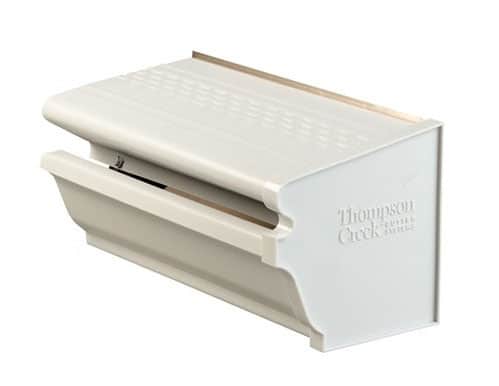Gutters do more than simply divert rainwater to your downspouts — these simple devices play a critical role in preventing costly damage to the structural integrity of your home. Of course, like everything that’s constantly exposed to the elements, gutters eventually break down and need repair or replacement. If you’re not sure when to replace gutters, you’re not alone.
Here at Thompson Creek, our team of home improvement experts have compiled this handy rain gutter replacement checklist to help you know when it’s time to upgrade your gutter system.
1. Your Gutters Are Overflowing
If rainwater and melting snow flows straight off your roof instead of through your gutters and downspouts, it’s time to take a closer look at your gutter system.
Leaves, twigs, and dirt can clog up your gutters, and if that’s what’s causing the overflow, the solution may simply be a thorough gutter cleaning. On the other hand, overflowing gutters can also be a sign that your gutters are simply too narrow to handle the volume of water coming off your roof. Gutters that don’t slope enough toward your downspouts can also trigger overflowing.
2. Your Gutters Have Holes or Cracks
Over time, UV rays, temperature changes, wind, and pollution all cause the materials in your gutters to break down. When that happens, you might notice that your gutters have developed small holes or cracks that drip during a heavy rainfall or when snow on your roof melts.
While it may be possible to patch some small holes, chances are good that once your gutters start to leak, it’s time to start looking at rain gutter replacement.
3. Your Gutters Are Sagging or Pulling Away
Sagging gutters are one of the easiest ways to recognize when to replace gutters because a sagging gutter simply won’t drain properly.
Another common sign is when your gutters start to protrude away from your roof line. This can be caused by improper installation, storm damage, or rotting fascia boards. Unless the gutters aren’t flush against your house, water off your roof will simply run directly downward rather than through the gutters.
4. Your Basement Is Always Damp
Your gutter system is designed to channel water away from the foundation of your home. Gutters that aren’t working properly may cause the water from your roof to collect around your foundation and lead to serious erosion problems.
Over time, excess water from your roof can work its way down your foundation wall and seep into your basement. Worse yet, when the mercury dips during the winter, water from your damaged gutters can freeze inside small cracks in your foundation wall. If that happens, you’ll be faced with a massive repair bill.
5. Your Landscape Plantings Are Damaged
Another way to know when to replace gutters is to take a look at your trees, hedges, and shrubs near your house. If you notice that the roots are exposed, that could be a sign that your gutter system isn’t performing as it should.
Soil erosion can be the result of overflowing gutters that dump large volumes of water directly onto your hedges and shrubs during major weather events. Exposed tree roots can also indicate that your downspouts aren’t set up properly, and that can cause soil loss in concentrated areas throughout your yard.
6. Your Siding or Foundation Are Stained
Stains on your siding or foundation are typically an indication that your gutters are overflowing, and not working properly.
Learn More About When to Replace Gutters
To find out if it’s time for rain gutter replacement at your home, contact Thompson Creek today for a no-obligation quote.


